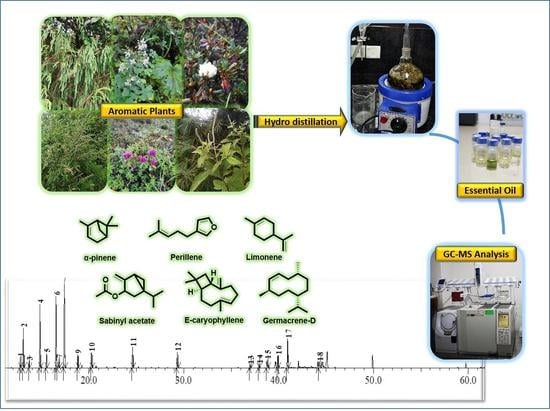Essential Oils from Six Aromatic Plants of Langtang National Park: Insights on Their Chemical Constituents via GC-MS Analysis
Abstract
1. Introduction
2. Materials and Methods
2.1. Plant Collection
2.2. Reagents
2.3. Extraction of Essential Oil
2.4. GC-MS Analysis
3. Results
4. Discussion
5. Conclusions
Supplementary Materials
Author Contributions
Funding
Institutional Review Board Statement
Informed Consent Statement
Data Availability Statement
Acknowledgments
Conflicts of Interest
References
- Karki, J. Status Paper of Langtang National Park. In Proceedings of the Grassland Ecology and Management in Protected Areas of Nepal, Kathmandu, Nepal, 15–19 March 1999. [Google Scholar] [CrossRef]
- Humagain, K.; Shrestha, K.K. Medicinal plants in Rasuwa district, central Nepal: Trade and livelihood. Bot. Orient. J. Plant Sci. 2010, 6, 39–46. [Google Scholar] [CrossRef]
- Shafi, A.; Zahoor, I. Chapter 12-Metabolomics of Medicinal and Aromatic Plants: Goldmines of Secondary Metabolites for Herbal Medicine Research. In Medicinal and Aromatic Plants; Aftab, T., Hakeem, K.R., Eds.; Academic Press: New York, NY, USA, 2021; pp. 261–287. [Google Scholar] [CrossRef]
- Novais, C.; Pereira, C.; Molina, A.K.; Liberal, N.; Dias, M.I.; Añibarro-Ortega, M.; Alves, M.J.; Calhelha, R.C.; Ferreira, I.C.; Barros, L. Bioactive and nutritional potential of medicinal and aromatic plant (MAP) seasoning mixtures. Molecules 2021, 26, 1587. [Google Scholar] [CrossRef]
- Mckenna, J.M. Strategic Segmentation Analysis: Nepal: Medicinal and Aromatic Plants; World Bank Group: Washington, DC, USA, 2018. [Google Scholar]
- Rehman, R.; Asif Hanif, M. Biosynthetic factories of essential oils: The aromatic plants. Nat. Prod. Chem. Res. 2016, 4, 227. [Google Scholar] [CrossRef]
- Schnaubelt, K. Essential oil therapy according to traditional Chinese medical concepts. Int. J. Aromather. 2005, 15, 98–105. [Google Scholar] [CrossRef]
- Mothana, R.A.; Al-Said, M.S.; Al-Yahya, M.A.; Al-Rehaily, A.J.; Khaled, J.M. GC and GC/MS analysis of essential oil composition of the endemic Soqotraen Leucas virgata Balf.f. and its antimicrobial and antioxidant activities. Int. J. Mol. Sci. 2013, 14, 23129–23139. [Google Scholar] [CrossRef]
- Dhifi, W.; Bellili, S.; Jazi, S.; Bahloul, N.; Mnif, W. Essential oils’ chemical characterization and investigation of some biological activities: A critical review. Medicines 2016, 3, 25. [Google Scholar] [CrossRef]
- Daferera, D.J.; Ziogas, B.N.; Polissiou, M.G. GC-MS analysis of essential oils from some Greek aromatic plants and their fungitoxicity on Penicillium digitatum. J. Agric. Food Chem. 2000, 48, 2576–2581. [Google Scholar] [CrossRef]
- Lichtenthaler, H.K. The 1-Deoxy-D-xylulose-5-phosphate pathway of isoprenoid biosynthesis in plants. Annu. Rev. Plant Physiol. Plant Mol. Biol. 1999, 50, 47–65. [Google Scholar] [CrossRef]
- Dewick, P.M. The biosynthesis of C5–C25 terpenoid compounds. Nat. Prod. Rep. 2002, 19, 181–222. [Google Scholar] [CrossRef]
- Gershenzon, J.; Dudareva, N. The function of terpene natural products in the natural world. Nat. Chem. Biol. 2007, 3, 408–414. [Google Scholar] [CrossRef]
- Modzelewska, A.; Sur, S.; Kumar, S.; Khan, S. Sesquiterpenes: Natural products that decrease cancer growth. Curr. Med. Chem.-Anti-Cancer Agents 2005, 5, 477–499. [Google Scholar] [CrossRef] [PubMed]
- Cox-Georgian, D.; Ramadoss, N.; Dona, C.; Basu, C. Therapeutic and Medicinal Uses of Terpenes. In Medicinal Plants: From Farm to Pharmacy; Joshee, N., Dhekney, S.A., Parajuli, P., Eds.; Springer International Publishing: Cham, Switzerland, 2019; pp. 333–359. ISBN 978-3-030-31269-5. [Google Scholar] [CrossRef]
- Adams, R.P. Identification of Essential Oil Components by Gas Chromatography/Mass Spectrometry, 4th ed.; Adams, R.P., Ed.; Allured Publishing Corporation: Carol Stream, IL, USA, 2007; p. 804. [Google Scholar]
- Angioni, A.; Barra, A.; Russo, M.T.; Coroneo, V.; Dessí, S.; Cabras, P. Chemical composition of the essential oils of Juniperus from ripe and unripe berries and leaves and their antimicrobial activity. J. Agric. Food Chem. 2003, 51, 3073–3078. [Google Scholar] [CrossRef] [PubMed]
- Stefanakis, M.K.; Papaioannou, C.; Lianopoulou, V.; Philotheou-Panou, E.; Giannakoula, A.E.; Lazari, D.M. Seasonal variation of aromatic plants under cultivation conditions. Plants 2022, 11, 2083. [Google Scholar] [CrossRef] [PubMed]
- Marriott, P.J.; Shellie, R.; Cornwell, C. Gas chromatographic technologies for the analysis of essential oils. J. Chromatogr. A 2001, 936, 1–22. [Google Scholar] [CrossRef] [PubMed]
- Gale, J. Plants and altitude—Revisited. Ann. Bot. 2004, 94, 199. [Google Scholar] [CrossRef] [PubMed]
- Kour, J.; Balgotra, S.; Rajput, P.; Kour, H.; Verma, P.K.; Sawant, S.D. Medicinal Value of High-Altitude Plants of Indian Himalaya. In Botanical Leads for Drug Discovery, 1st ed.; Singh, B., Ed.; Springer Nature: Singapore, 2020; pp. 295–324. [Google Scholar] [CrossRef]
- Innocenti, G.; Dall’Acqua, S.; Scialino, G.; Banfi, E.; Sosa, S.; Gurung, K.; Barbera, M.; Carrara, M. Chemical composition and biological properties of Rhododendron anthopogon essential oil. Molecules 2010, 15, 2326–2338. [Google Scholar] [CrossRef]
- Dosoky, N.S.; Satyal, P.; Pokharel, S.; Setzer, W.N. Chemical composition, enantiomeric distribution, and biological activities of Rhododendron anthopogon leaf essential oil from Nepal. Nat. Prod. Commun. 2016, 11, 1934578X1601101230. [Google Scholar] [CrossRef]
- Joshi, S.; Thapa, P. Chemical composition and antioxidant activity of Rhododendron lepidotum Wall. ex D. Don, essential oil from Nepal. Int. J. Adv. Res. Chem. Sci. 2018, 5, 12–18. [Google Scholar] [CrossRef]
- Satyal, P.; Dosoky, N.S.; Kincer, B.L.; Setzer, W.N. Chemical compositions and biological activities of Amomum subulatum essential oils from Nepal. Nat. Prod. Commun. 2012, 7, 1934578X1200700935. [Google Scholar] [CrossRef]
- Satyal, P.; Paudel, P.; Kafle, A.; Pokharel, S.K.; Lamichhane, B.; Dosoky, N.S.; Moriarity, D.M.; Setzer, W.N. Bioactivities of volatile components from Nepalese. Artemisia Species. Nat. Prod. Commun. 2012, 7, 1934578X1200701228. [Google Scholar] [CrossRef]
- Satyal, P.; Paudel, P.; Poudel, A.; Dosoky, N.S.; Moriarity, D.M.; Vogler, B.; Setzer, W.N. Chemical compositions, phytotoxicity, and biological activities of Acorus Calamus essential oils from Nepal. Nat. Prod. Commun. 2013, 8, 1934578X1300800839. [Google Scholar] [CrossRef]
- Shrestha, N.; Shrestha, K.K. Threatened Medicinal Plants in Langtang National Park, Nepal. In Medicinal Plants in Nepal: An Anthology of Contemporary Research; Jha, P.K., Karmacharya, S.B., Chettri, M.K., Thapa, C.B., Shrestha, B.B., Eds.; Ecological Society (ECOS): Kathmandu, Nepal, 2008; pp. 246–251. [Google Scholar]
- Clevenger, J. Apparatus for the determination of volatile oil*. J. Am. Pharm. Assoc. 1928, 17, 345–349. [Google Scholar] [CrossRef]
- Guleria, S.; Jaitak, V.; Saini, R.; Kaul, V.K.; Lal, B.; Babu, G.K.; Singh, B.; Singh, R. Comparative studies of volatile oil composition of Rhododendron anthopogon by hydrodistillation, supercritical carbon dioxide extraction and head space analysis. Nat. Prod. Res. 2011, 25, 1271–1277. [Google Scholar] [CrossRef] [PubMed]
- Jesionek, A.; Kokotkiewicz, A.; Mikosik-Roczynska, A.; Ciesielska-Figlon, K.; Luczkiewicz, P.; Bucinski, A.; Daca, A.; Witkowski, J.M.; Bryl, E.; Zabiegala, B.; et al. Chemical variability of Rhododendron tomentosum (Ledum palustre) essential oils and their pro-apoptotic effect on lymphocytes and rheumatoid arthritis synoviocytes. Fitoterapia 2019, 139, 104402. [Google Scholar] [CrossRef]
- He, J.; Shang, X.; Dai, L.; Yang, X.; Li, B.; Wei, Y.; Zhang, J.; Pan, H. Chemical constituents, antibacterial, acaricidal and anti-inflammatory activities of the essential oils from four Rhododendron species. Front. Vet. Sci. 2022, 9, 2060. [Google Scholar] [CrossRef]
- Bai, L.; Jiao, M.L.; Zang, H.Y.; Guo, S.S.; Wang, Y.; Sang, Y.L.; Du, S.S. Chemical composition of essential oils from four Rhododendron species and their repellent activity against three stored-product insects. Environ. Sci. Pollut. Res. 2019, 26, 23198–23205. [Google Scholar] [CrossRef] [PubMed]
- Judzentiene, A.; Budiene, J.; Svediene, J.; Garjonyte, R. Toxic, radical scavenging, and antifungal activity of Rhododendron tomentosum H. essential oils. Molecules 2020, 25, 1676. [Google Scholar] [CrossRef]
- Schepetkin, I.A.; Özek, G.; Özek, T.; Kirpotina, L.N.; Khlebnikov, A.I.; Quinn, M.T. Chemical composition and immunomodulatory activity of essential oils from Rhododendron albiflorum. Molecules 2021, 26, 3652. [Google Scholar] [CrossRef]
- Chen, X.Y.; Wu, Y.X.; Li, Y.; Zhang, J.N.; Bi, S.F. Chemical composition and biological activity of the essential oil from Rhododendron anwheiense flowers. Chem. Nat. Compd. 2022, 58, 947–950. [Google Scholar] [CrossRef]
- Belousova, N.I.; Domrachev, D.V.; Fursa, N.S.; Belousov, M.V. Composition of essential oil from Rhododendron caucasicum. Chem. Nat. Compd. 2017, 53, 574–575. [Google Scholar] [CrossRef]
- Kim, J.I. Anti-porcine epidemic diarrhea virus (PEDV) activity and antimicrobial activities of Artemisia dubia essential oil. Korean J. Microbiol. Biotechnol. 2012, 40, 396–402. [Google Scholar] [CrossRef]
- Liang, J.Y.; Guo, S.S.; Zhang, W.J.; Geng, Z.F.; Deng, Z.W.; Du, S.S.; Zhang, J. Fumigant and repellent activities of essential oil extracted from Artemisia dubia and its main compounds against two stored product pests. Nat. Prod. Res. 2017, 32, 1234–1238. [Google Scholar] [CrossRef] [PubMed]
- Shameem, S.A.; Khan, K.Z.; Waza, A.A.; Banday, A.H.; Ramzan, A.; Shah, A.H.; Ganai, B.A. Chemical profile and biological activities of essential oil from flowers of Artemisia dubia Wall. ex Bess. growing wild in Western Himalaya, India. Asian J. Chem. 2019, 31, 1762–1766. [Google Scholar] [CrossRef]
- Padalia, R.C.; Verma, R.S.; Chauhan, A.; Chanotiya, C.S. Chemical composition of leaf and root essential oils of Boenninghausenia albiflora Reichb. from northern India. Nat. Prod. Res. 2011, 26, 2040–2044. [Google Scholar] [CrossRef] [PubMed]
- Padalia, R.C.; Verma, R.S.; Chauhan, A. Compositional Variations in Volatile Constituents of Boenninghausenia albiflora Reichb. from Western Himalaya. Natl. Acad. Sci. Lett. 2013, 36, 635–640. [Google Scholar] [CrossRef]
- Thappa, R.K.; Agarwal, S.G.; Kapahl, B.K.; Srivastava, T.N. Chemosystematics of the Himalayan Elsholtzia. J. Essent. Oil Res. 1999, 11, 97–103. [Google Scholar] [CrossRef]
- Liang, J.Y.; Ning, A.Q.; Lu, P.Y.; Shao, Y.Z.; Xu, J.; Yang, Y.Y.; Wang, H.L. Chemical composition and biological activity of essential oil extracted from the aerial part of Elsholtzia fruticosa against Ditylenchus destructor. J. Essent. Oil Bear. Plants 2020, 23, 575–582. [Google Scholar] [CrossRef]
- Fusani, P.; Ronga, D.; Carminati, D.; Mandrioli, M.; Manicardi, G.C.; Giannì, S.; Tava, A. Composition and biological activity of essential oils from Artemisia roxburghiana Besser and Elsholtzia fruticosa Rehder cultivated in Italy. Ind. Crops Prod. 2022, 187, 115317. [Google Scholar] [CrossRef]
- Adams, R.P.; Thappa, R.K.; Agarwal, S.G.; Kapahi, B.K.; Srivastava, T.N.; Chaudhary, R.P. The leaf essential oil of Juniperus recurva Buch.-Ham. ex D. Don from India and Nepal compared with J. recurva var. squamata (D. Don) Parl. J. Essent. Oil Res. 1998, 10, 21–24. [Google Scholar] [CrossRef]
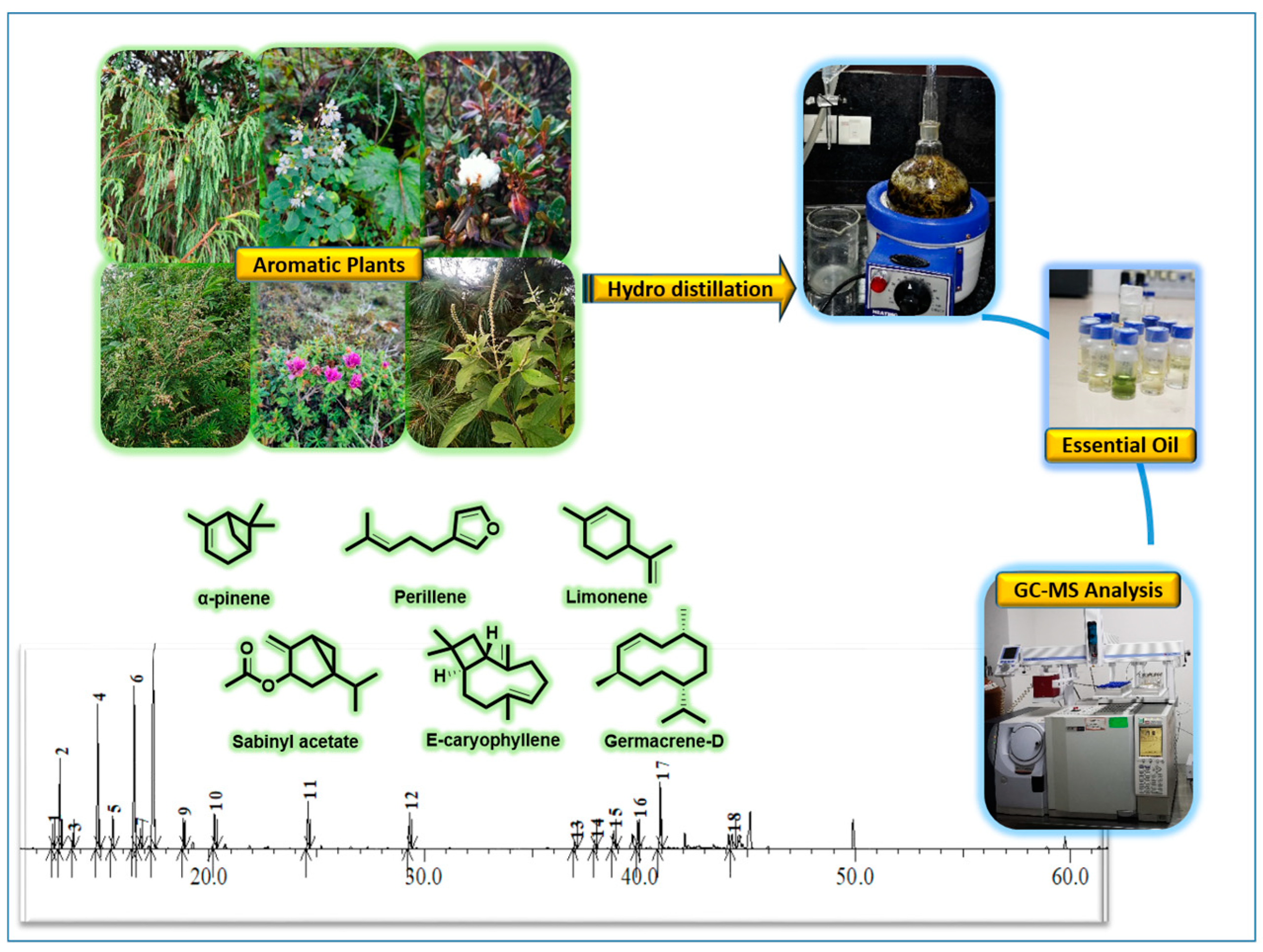
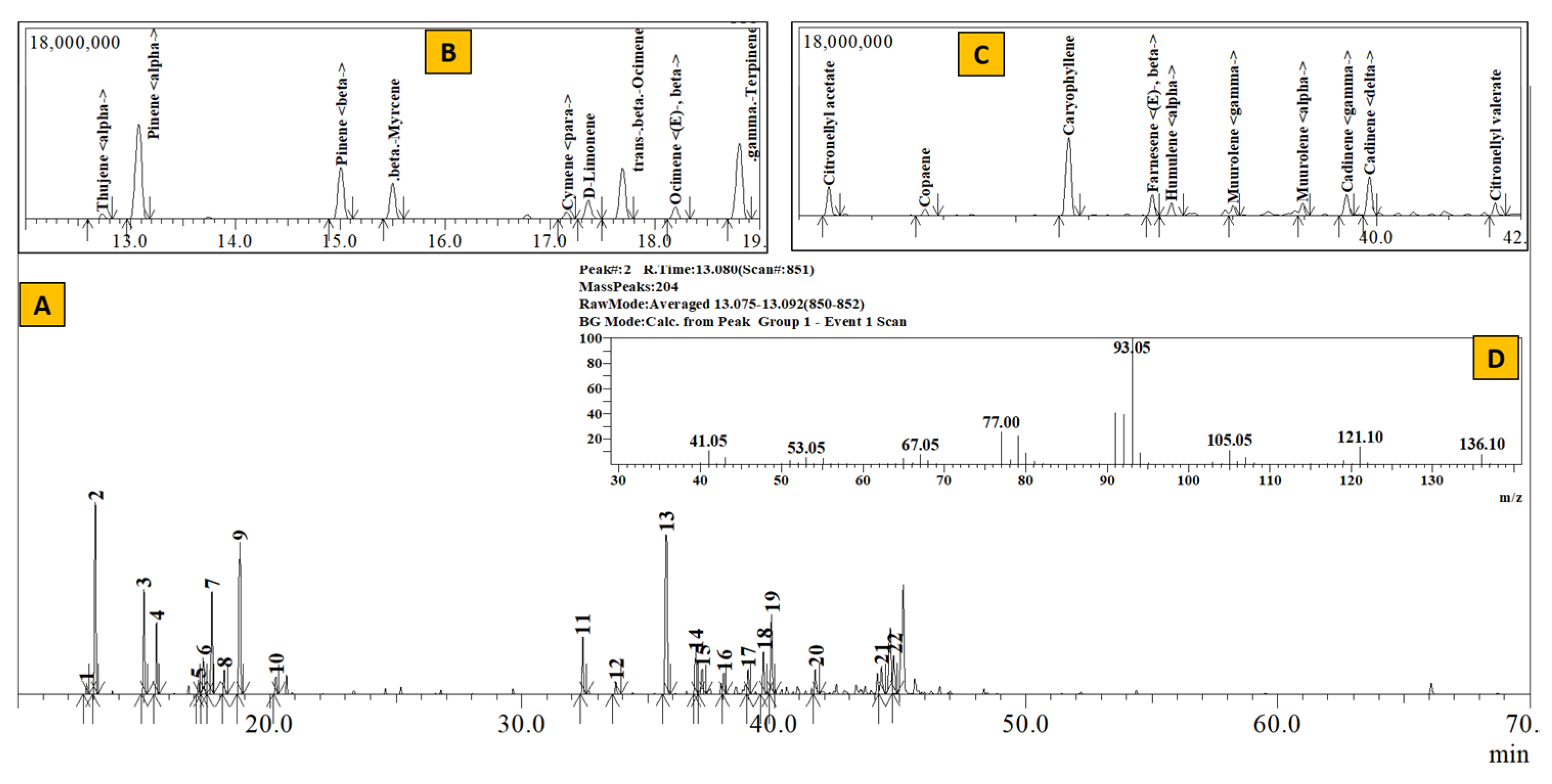
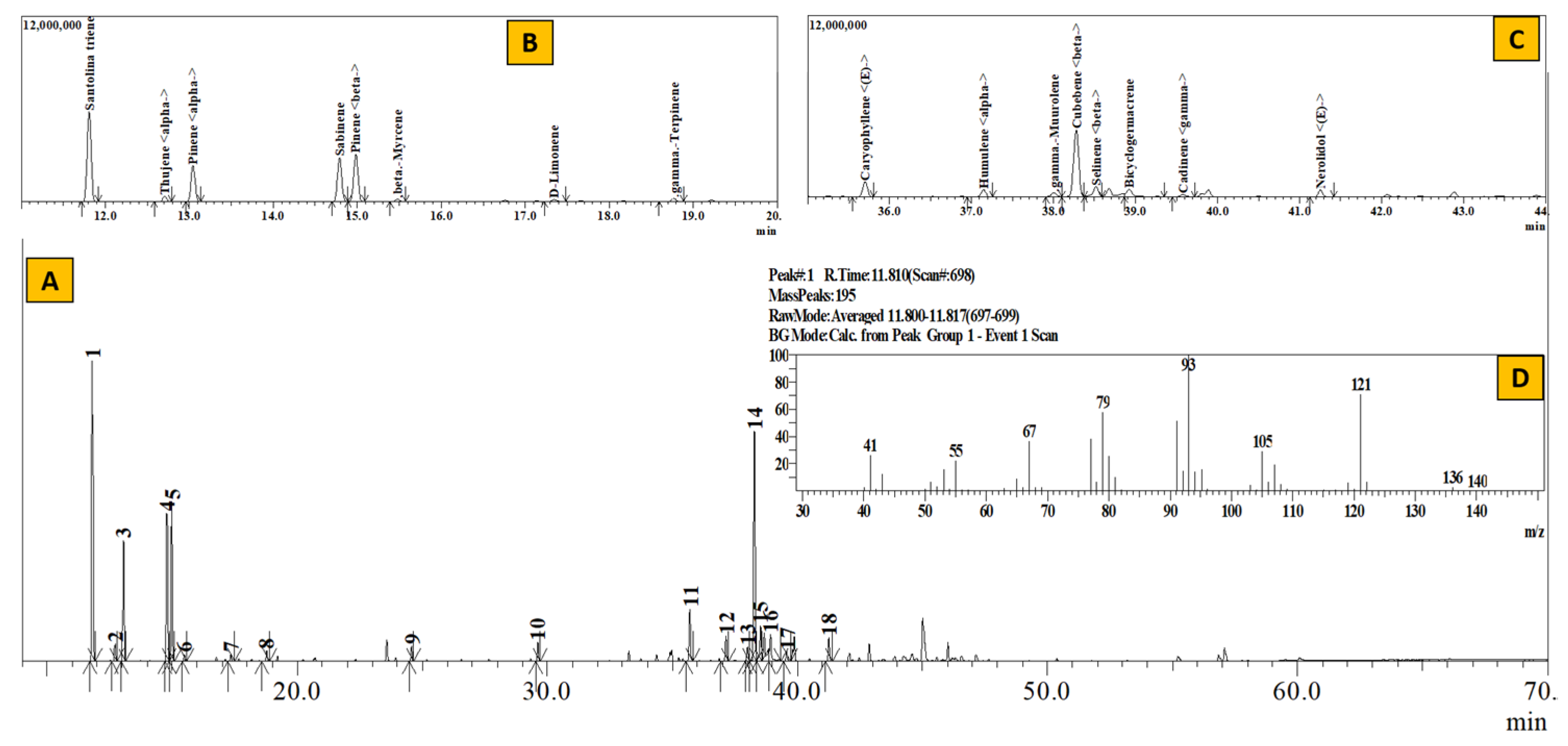
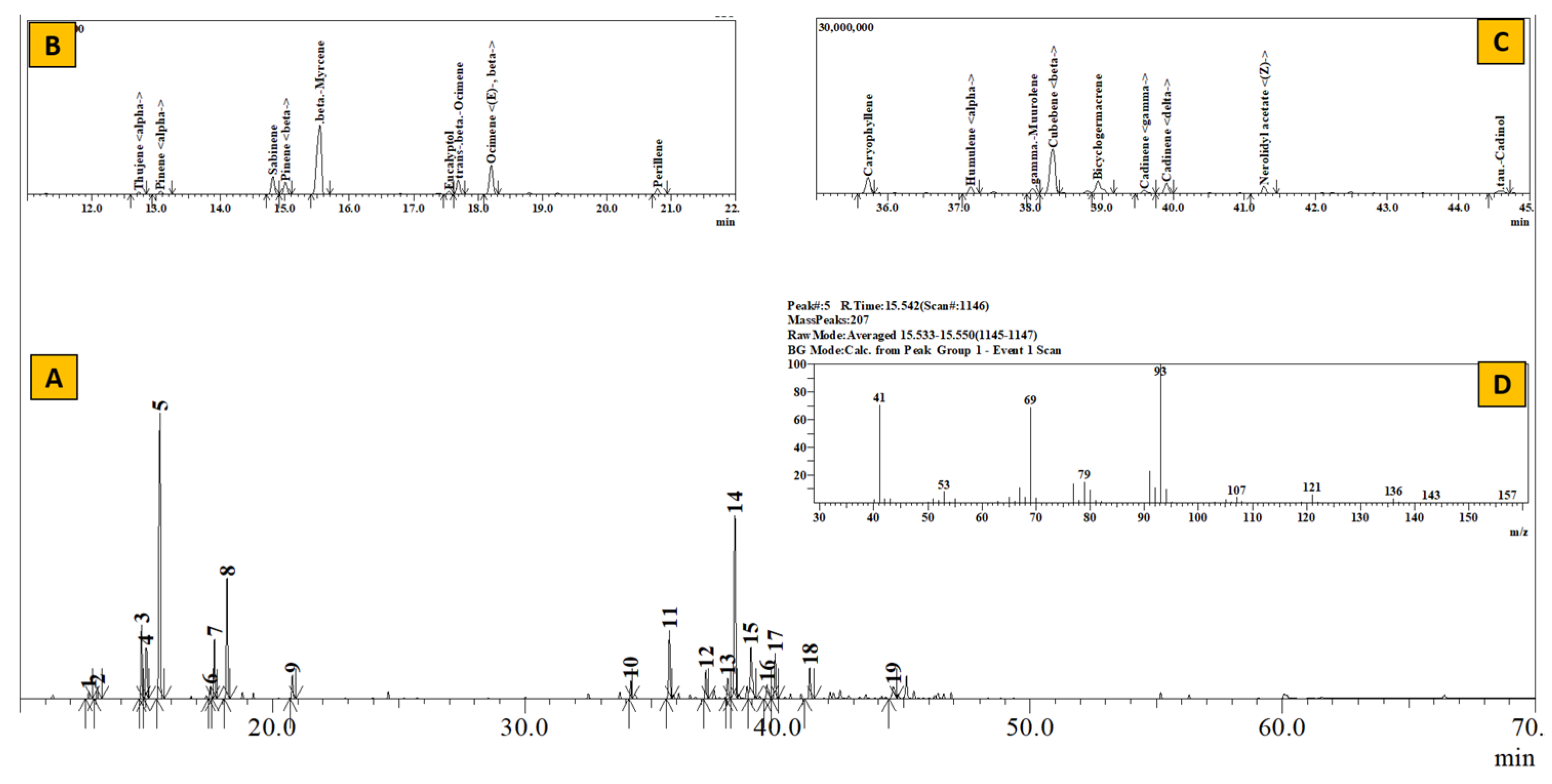
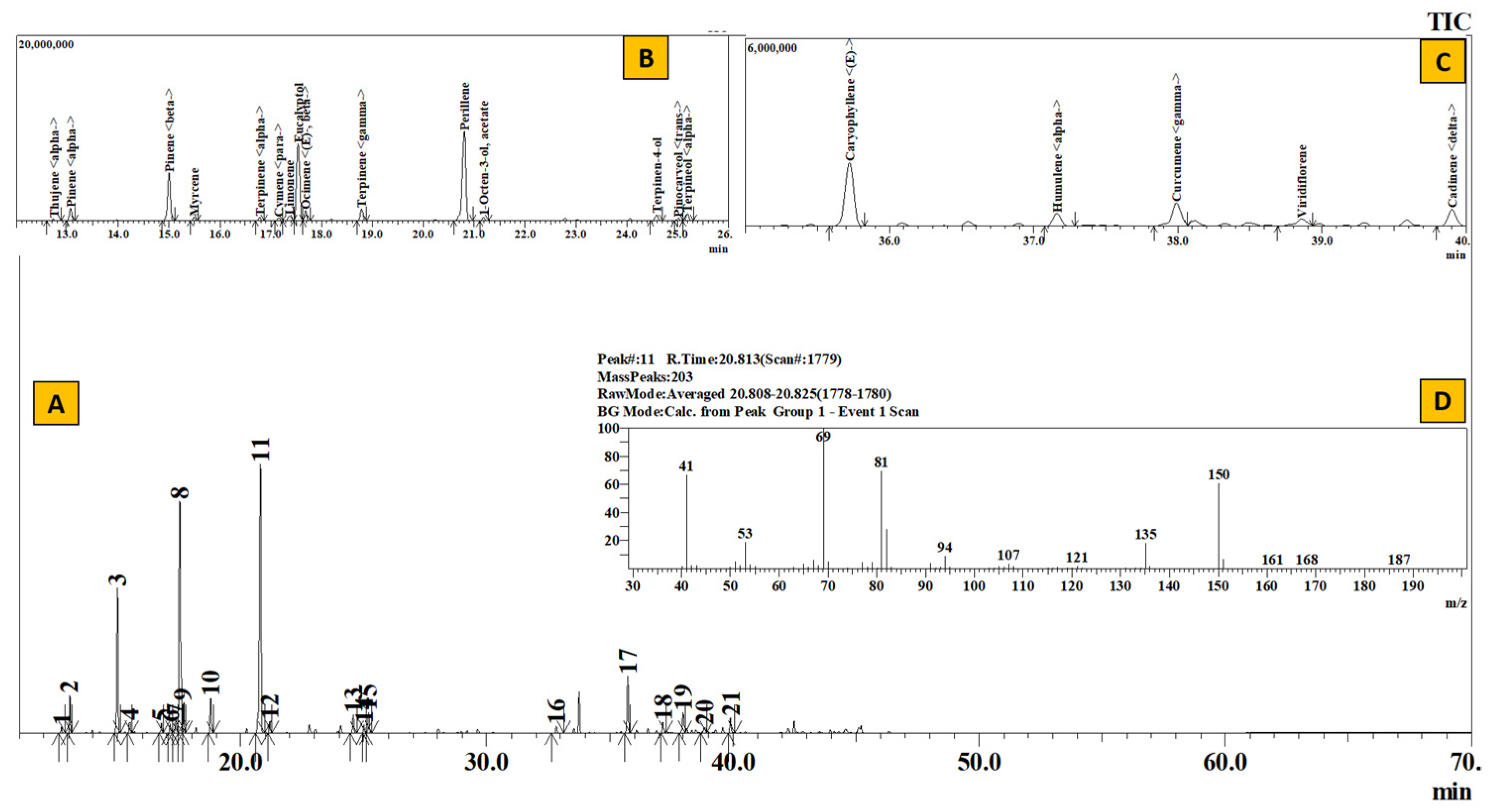
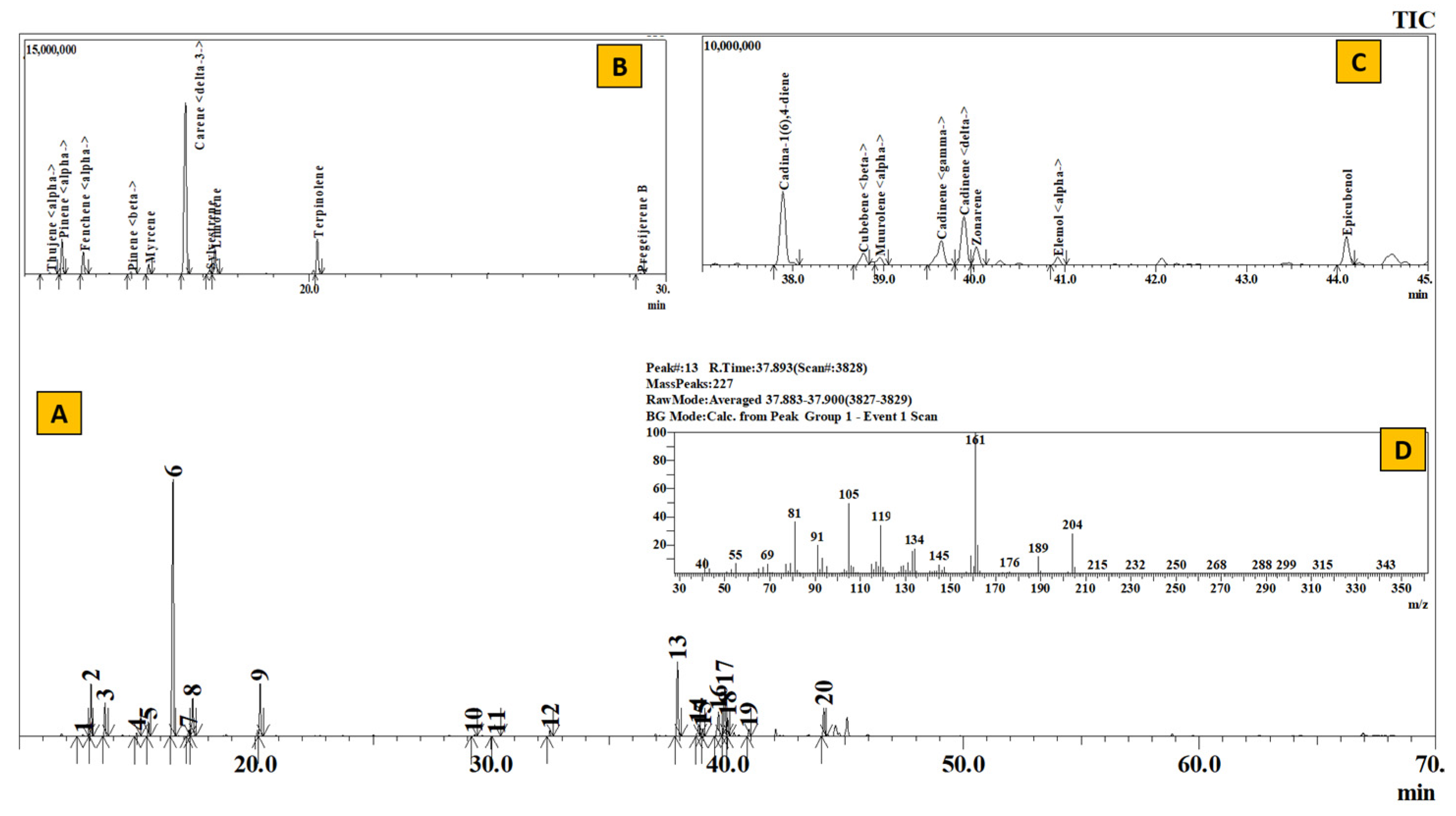
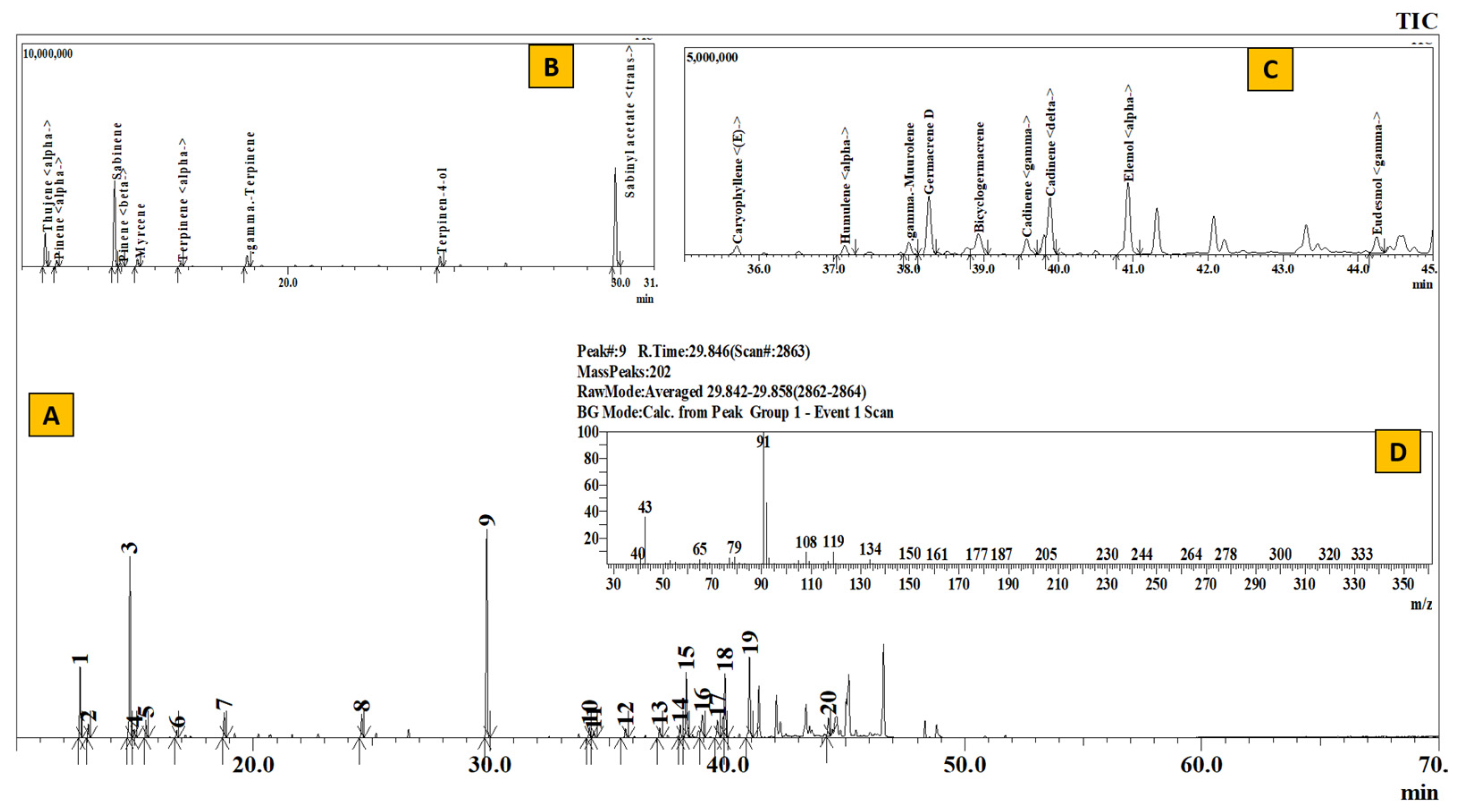
| S.N. | Name | Family | Parts Used for Extraction | Sample Code | Location | Altitude (m) |
|---|---|---|---|---|---|---|
| 1. | Elsholtzia fruticosa (D. Don) Rehder | Lamiaceae | Leaves | EL | Deurali, Rasuwa | 2675 |
| 2. | Boenninghausenia albiflora (Hook.) Rchb. ex Meisn. | Rutaceae | Leaves | BE | Deurali to Dhimsa | 2760 |
| 3 | Artemisia dubia Wall. ex Besser | Asteraceae | Leaves | AR | Chandanbari to Cholangpati | 3333 |
| 4 | Rhododendron anthopogon D. Don | Ericaceae | Leaves | AN | Lauribina hills | 3964 |
| 5 | Juniperus recurva Buch.-Ham. ex D. Don | Cupressaceae | Leaves | JL | Lauribina hills | 3964 |
| 6 | Rhododendron setosum D. Don | Ericaceae | Leaves | SE | Lauribina to Gosainkunda | 4280 |
| S.N. | Components | Composition (Area %) | |||||
|---|---|---|---|---|---|---|---|
| AN | AR | BE | EL | JL | SE | ||
| 1 | Santolina triene | - | 21.82 | - | - | - | - |
| 2 | α-thujene | 1.38 | 1.23 | 0.54 | 0.47 | 0.31 | 6.62 |
| 3 | α -pinene | 14.25 | 8.90 | 0.81 | 2.98 | 6.53 | 1.37 |
| 4 | α -fenchene | - | - | - | - | 4.20 | - |
| 5 | Sabinene | - | 11.13 | 5.02 | - | 0.04 | 18.67 |
| 6 | β-pinene | 7.44 | 12.30 | 3.56 | 13.59 | 0.53 | 0.93 |
| 7 | β-myrcene | 4.65 | 0.59 | 27.04 | 0.83 | 1.80 | 1.69 |
| 8 | δ-3-carene | - | - | - | - | 43.88 | - |
| 9 | α -terpinene | - | - | 0.20 | 0.85 | - | 0.84 |
| 10 | p-cymene | 0.95 | - | - | 0.78 | - | - |
| 11 | Sylvestrene | - | - | - | - | 0.88 | - |
| 12 | D-Limonene | 2.68 | 0.69 | - | 1.68 | 5.60 | |
| 13 | Eucalyptol | - | - | 0.86 | 23.67 | - | - |
| 14 | Z-β-ocimene | 7.25 | - | 4.05 | - | - | |
| 15 | E-β-ocimene | 1.62 | - | 8.95 | 2.46 | - | - |
| 16 | γ-terpinene | 12.16 | 0.90 | 0.46 | 2.95 | - | 2.58 |
| 17 | α -terpinolene | 1.27 | - | - | - | 7.24 | - |
| 18 | Perillene | - | - | 1.73 | 32.29 | - | - |
| Total | 53.65 | 57.56 | 53.22 | 82.55 | 71.01 | 32.7 | |
| S.N. | Components | Composition (Area %) | |||||
|---|---|---|---|---|---|---|---|
| AN | AR | BE | EL | JL | SE | ||
| Alcohols | |||||||
| 1 | 1-Octen-3-ol, acetate | - | - | - | 0.97 | - | - |
| 2 | Terpinen-4-ol | - | 1.25 | 0.58 | 1.74 | - | 2.58 |
| 3 | Trans-pinocarveol | - | - | - | 0.75 | - | - |
| 4 | α-terpineol | - | - | 1.90 | - | - | |
| Total | - | 1.24 | 0.58 | 5.36 | - | 2.58 | |
| 5 | Pregeijerene B | - | - | - | - | 0.30 | - |
| Total | 0.30 | ||||||
| Esters | |||||||
| 6 | Lavandulyl acetate | - | 1.48 | - | - | - | - |
| 7 | Trans-sabinyl acetate | - | - | - | - | - | 24.11 |
| 8 | Citronellyl acetate | 4.18 | - | - | - | - | - |
| Total | 4.18 | 1.48 | - | - | - | 24.11 | |
| Phenolic Compounds | |||||||
| 9 | Eugenol | - | - | - | 0.78 | - | - |
| Total | 0.78 | ||||||
| S.N. | Component | Composition (Area %) | |||||
|---|---|---|---|---|---|---|---|
| AN | AR | BE | EL | JL | SE | ||
| 1 | α-cubebene | - | - | 0.43 | - | 0.84 | - |
| 2 | Copaene | 0.92 | - | - | - | - | - |
| 3 | (-)-β-bourbonene | - | - | 1.41 | - | - | 1.27 |
| 4 | β-elemene | - | - | - | - | - | 0.81 |
| 5 | E-Caryophyllene | 14.63 | 4.65 | 5.79 | 5.48 | - | 1.33 |
| 6 | E-β-farnesene | 3.01 | - | - | - | - | - |
| 7 | α-humulene | 1.97 | 2.23 | 2.29 | 1.09 | - | 1.20 |
| 8 | Cadina-1(6),4-diene | - | - | - | - | 11.41 | - |
| 9 | γ-curcumene | - | - | - | 2.33 | - | - |
| 10 | γ-muurolene | 1.62 | 1.33 | 1.86 | - | - | 1.66 |
| 11 | Germacrene D | - | - | - | - | - | 7.67 |
| 12 | β-cubebene | - | 21.77 | 18.26 | - | - | - |
| 13 | β-selinene | - | 3.55 | - | - | - | - |
| 14 | γ-amorphene | - | - | - | - | 0.20 | - |
| 15 | Viridiflorene | - | - | - | 0.93 | - | - |
| 16 | Bicyclogermacrene | - | 3.15 | 6.17 | - | - | 4.16 |
| 17 | α-muurolene | 1.90 | - | - | - | 1.10 | - |
| 18 | γ-cadinene | 3.32 | 0.99 | 1.55 | - | - | 2.59 |
| 19 | δ-cadinene | 6.70 | - | 3.62 | 1.42 | 7.57 | 7.51 |
| 20 | Zonarene | - | - | - | - | 2.60 | - |
| Total | 34.07 | 37.67 | 41.38 | 11.25 | 23.72 | 28.2 | |
| S.N. | Component | Composition (Area %) | |||||
|---|---|---|---|---|---|---|---|
| AN | AR | BE | EL | JL | SE | ||
| 1 | α-elemol | - | - | - | - | 1.01 | 10.01 |
| 2 | E-Nerolidol | - | 2.04 | 2.42 | - | - | - |
| 3 | Citronellyl valerate | 1.95 | - | - | - | - | - |
| 4 | Epicubenol | - | - | - | - | 4.19 | - |
| 5 | γ-eudesmol | 3.00 | - | - | - | - | 2.41 |
| 6 | τ-cadinol | - | - | 1.94 | - | - | - |
| 7 | α -muurolol | 3.17 | - | - | - | - | - |
| 8 | m-camphorene | - | - | 0.45 | - | - | - |
| Total | 8.12 | 2.04 | 4.81 | - | 5.2 | 12.42 | |
Disclaimer/Publisher’s Note: The statements, opinions and data contained in all publications are solely those of the individual author(s) and contributor(s) and not of MDPI and/or the editor(s). MDPI and/or the editor(s) disclaim responsibility for any injury to people or property resulting from any ideas, methods, instructions or products referred to in the content. |
© 2023 by the authors. Licensee MDPI, Basel, Switzerland. This article is an open access article distributed under the terms and conditions of the Creative Commons Attribution (CC BY) license (https://creativecommons.org/licenses/by/4.0/).
Share and Cite
Pradhan, S.; Paudel, H.R.; Maharjan, R.; Sharma, K. Essential Oils from Six Aromatic Plants of Langtang National Park: Insights on Their Chemical Constituents via GC-MS Analysis. Separations 2023, 10, 52. https://doi.org/10.3390/separations10010052
Pradhan S, Paudel HR, Maharjan R, Sharma K. Essential Oils from Six Aromatic Plants of Langtang National Park: Insights on Their Chemical Constituents via GC-MS Analysis. Separations. 2023; 10(1):52. https://doi.org/10.3390/separations10010052
Chicago/Turabian StylePradhan, Samjhana, Hem Raj Paudel, Romi Maharjan, and Kavita Sharma. 2023. "Essential Oils from Six Aromatic Plants of Langtang National Park: Insights on Their Chemical Constituents via GC-MS Analysis" Separations 10, no. 1: 52. https://doi.org/10.3390/separations10010052
APA StylePradhan, S., Paudel, H. R., Maharjan, R., & Sharma, K. (2023). Essential Oils from Six Aromatic Plants of Langtang National Park: Insights on Their Chemical Constituents via GC-MS Analysis. Separations, 10(1), 52. https://doi.org/10.3390/separations10010052








